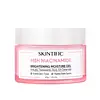What's inside
What's inside
 Key Ingredients
Key Ingredients

 Benefits
Benefits

 Concerns
Concerns

No concerns
 Ingredients Side-by-side
Ingredients Side-by-side

Water
Skin ConditioningButylene Glycol
HumectantIsononyl Isononanoate
EmollientGlycerin
HumectantNiacinamide
SmoothingCeramide EOP
Skin ConditioningCeramide Ns
Skin ConditioningCentella Asiatica Extract
CleansingAlpha-Arbutin
AntioxidantCeramide NP
Skin ConditioningTranexamic Acid
AstringentCeramide As
Skin ConditioningCeramide AP
Skin ConditioningLimnanthes Alba Seed Oil
Skin ConditioningBetaine
HumectantJojoba Esters
EmollientHydroxyacetophenone
AntioxidantPanthenol
Skin Conditioning1,2-Hexanediol
Skin ConditioningCetearyl Olivate
Cyclohexasiloxane
EmollientSorbitan Olivate
EmulsifyingBis-PEG/PPG-20/5 PEG/PPG-20/5 Dimethicone
EmulsifyingMethoxy PEG/PPG-25/4 Dimethicone
EmulsifyingAcrylates/C10-30 Alkyl Acrylate Crosspolymer
Emulsion StabilisingDimethicone/Vinyl Dimethicone Crosspolymer
Skin ConditioningArmillaria Mellea Extract
Skin ConditioningPentylene Glycol
Skin ConditioningSaccharomyces Cerevisiae Extract
Skin ConditioningWater, Butylene Glycol, Isononyl Isononanoate, Glycerin, Niacinamide, Ceramide EOP, Ceramide Ns, Centella Asiatica Extract, Alpha-Arbutin, Ceramide NP, Tranexamic Acid, Ceramide As, Ceramide AP, Limnanthes Alba Seed Oil, Betaine, Jojoba Esters, Hydroxyacetophenone, Panthenol, 1,2-Hexanediol, Cetearyl Olivate, Cyclohexasiloxane, Sorbitan Olivate, Bis-PEG/PPG-20/5 PEG/PPG-20/5 Dimethicone, Methoxy PEG/PPG-25/4 Dimethicone, Acrylates/C10-30 Alkyl Acrylate Crosspolymer, Dimethicone/Vinyl Dimethicone Crosspolymer, Armillaria Mellea Extract, Pentylene Glycol, Saccharomyces Cerevisiae Extract
PEG-100 Stearate
Glyceryl Stearate
EmollientDimethicone/Vinyl Dimethicone Crosspolymer
Skin ConditioningBetaine
HumectantPalmitic Acid
EmollientStearic Acid
CleansingCetyl PEG/PPG-10/1 Dimethicone
EmulsifyingCarbomer
Emulsion StabilisingTromethamine
BufferingSodium Acrylate/Sodium Acryloyldimethyl Taurate Copolymer
Emulsion StabilisingPanthenol
Skin ConditioningIsohexadecane
EmollientCitrus Grandis Peel Oil
MaskingGlyceryl Stearate Citrate
EmollientXanthan Gum
EmulsifyingCitrus Aurantium Dulcis Oil
MaskingAcrylates/Ethylhexyl Acrylate Copolymer
Polysorbate 80
EmulsifyingCymbopogon Martini Oil
MaskingCitrus Aurantium Bergamia Fruit Oil
MaskingPelargonium Graveolens Flower Oil
MaskingHydrolyzed Hibiscus Esculentus Extract
Skin ConditioningLupinus Albus Seed Extract
Skin ConditioningMoringa Oleifera Seed Extract
Skin ConditioningOryza Sativa Bran Oil Extract
Skin ConditioningSorbitan Oleate
EmulsifyingCedrus Atlantica Bark Oil
MaskingMichelia Alba Flower Oil
MaskingSalvia Sclarea Oil
MaskingCananga Odorata Flower Oil
MaskingCeramide NP
Skin ConditioningHydrolyzed Sodium Hyaluronate
Skin ConditioningSodium Acetylated Hyaluronate
HumectantSodium Hyaluronate
HumectantEclipta Prostrata Extract
Skin ConditioningMelia Azadirachta Leaf Extract
Skin ConditioningMoringa Oleifera Seed Oil
EmollientCitrus Aurantifolia Oil
CleansingCinnamomum Cassia Leaf Oil
MaskingRose Flower Oil
MaskingPaeonia Officinalis Flower Extract
TonicPotassium Sorbate
PreservativeSodium Benzoate
MaskingCitric Acid
BufferingPEG-100 Stearate, Glyceryl Stearate, Dimethicone/Vinyl Dimethicone Crosspolymer, Betaine, Palmitic Acid, Stearic Acid, Cetyl PEG/PPG-10/1 Dimethicone, Carbomer, Tromethamine, Sodium Acrylate/Sodium Acryloyldimethyl Taurate Copolymer, Panthenol, Isohexadecane, Citrus Grandis Peel Oil, Glyceryl Stearate Citrate, Xanthan Gum, Citrus Aurantium Dulcis Oil, Acrylates/Ethylhexyl Acrylate Copolymer, Polysorbate 80, Cymbopogon Martini Oil, Citrus Aurantium Bergamia Fruit Oil, Pelargonium Graveolens Flower Oil, Hydrolyzed Hibiscus Esculentus Extract, Lupinus Albus Seed Extract, Moringa Oleifera Seed Extract, Oryza Sativa Bran Oil Extract, Sorbitan Oleate, Cedrus Atlantica Bark Oil, Michelia Alba Flower Oil, Salvia Sclarea Oil, Cananga Odorata Flower Oil, Ceramide NP, Hydrolyzed Sodium Hyaluronate, Sodium Acetylated Hyaluronate, Sodium Hyaluronate, Eclipta Prostrata Extract, Melia Azadirachta Leaf Extract, Moringa Oleifera Seed Oil, Citrus Aurantifolia Oil, Cinnamomum Cassia Leaf Oil, Rose Flower Oil, Paeonia Officinalis Flower Extract, Potassium Sorbate, Sodium Benzoate, Citric Acid
 Reviews
Reviews

Ingredients Explained
These ingredients are found in both products.
Ingredients higher up in an ingredient list are typically present in a larger amount.
Betaine is a common humectant (a substance that promotes retention of moisture). It's known to be gentle on the skin and can help balance hydration.
This ingredient is best for improving hydration and soothing irritated skin. Studies also show it helps even out skin tone.
Fun fact: Betaine is naturally created in the skin and body. The kind found within cosmetic products can be either plant-derived or synthetic.
Another name for betaine is trimethylglycine.
Learn more about BetaineCeramide NP is a type of ceramide and formally known as ceramide 3.
Ceramides are intercellular lipids naturally found in our skin that bonds dead skin cells together to create a barrier. They are known for their ability to hold water and thus are a great ingredient for dry skin.
Ceramides are an important building block for our skin barrier. A stronger barrier helps the skin look more firm and hydrated. By bolstering the skin ceramides act as a barrier against irritating ingredients. This can help with inflammation as well.
If you would like to eat ceramides, sweet potatoes contain a small amount.
Read more about other common types of ceramides here:
Ceramide AP
Ceramide EOP
This ingredient is a silicone used to improve the texture of products and absorb oil. It does not get absorbed into the skin.
Like other silicones, Dimethicone/Vinyl Dimethicone Crosspolymer helps condition the skin by creating a barrier. In this sense, it can act as an emollient and trap moisture in.
This ingredient is a type of elastomer.
Learn more about Dimethicone/Vinyl Dimethicone CrosspolymerPanthenol is a common ingredient that helps hydrate and soothe the skin. It is found naturally in our skin and hair.
There are two forms of panthenol: D and L.
D-panthenol is also known as dexpanthenol. Most cosmetics use dexpanthenol or a mixture of D and L-panthenol.
Panthenol is famous due to its ability to go deeper into the skin's layers. Using this ingredient has numerous pros (and no cons):
Like hyaluronic acid, panthenol is a humectant. Humectants are able to bind and hold large amounts of water to keep skin hydrated.
This ingredient works well for wound healing. It works by increasing tissue in the wound and helps close open wounds.
Once oxidized, panthenol converts to pantothenic acid. Panthothenic acid is found in all living cells.
This ingredient is also referred to as pro-vitamin B5.
Learn more about Panthenol